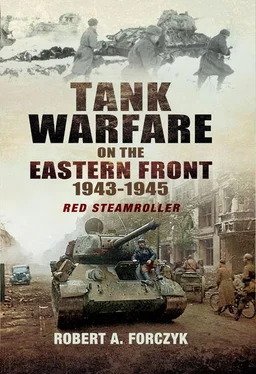By 7 July, Model decided to focus all his combat power in just the Ol’khovatka and Ponyri sectors, while essentially shifting to the defence on the rest of his front. At 0630 hours, Harpe’s XXXXI Panzerkorps attacked Ponyri from the north with the 292.Infanterie-Division supported by Ferdinands and assault guns, while 18.Panzer-Division attacked from the west. Enshin’s defence was rock solid and supported by over 300 artillery pieces, which repulsed four German attacks. It was not until 1100 hours that a fifth attack succeeded in gaining some ground and getting into the edge of Ponyri, but the rest of the day was consumed in Stalingrad-style urban combat that accomplished nothing. Nor did Scheller’s 9.Panzer-Division achieve anything useful; it advanced 3km southwest in an effort to outflank Ponyri before running into mines and an impenetrable blocking position held by the 43rd Tank Regiment (30 T-34s) and the 1st Anti-Tank Brigade; Scheller lost nine tanks knocked out and 30 more immobilized by mechanical defects and damage. The fact that an entire German Panzerkorps could not capture a town held by a rifle division indicated the growing poverty of German resources.
Before Lemelsen could jump off on the morning of 7 July, Soviet A-20 bombers struck again and destroyed five Pz IV tanks in 2.Panzer-Division’s tactical assembly area. Following that rude shock, Lübbe formed Kampfgruppe Burmeister (Sauvant’s Tigers, Pz.Regt. 3, I./Pz. Gr. Regt. 304 (SPW), self-propelled artillery, Panzerjägers) under his most experienced armoured leader and ordered him to seize the corps objective – Ol’khovatka – while 20.Panzer-Division screened the extended right flank of XXXXVII Panzerkorps. Oberst Arnold Burmeister was one of the most experienced Panzer-Regiment commanders on the Eastern Front and German commanders were given wide tactical discretion under the mission-orders concept. Burmeister decided that before proceeding to Ol’khovatka that he needed to secure the Soviet-held village of Samodurovka, which was sniping at his Kampfgruppe with long-range anti-tank fire. His mass of armour struck units from the 140th Rifle Division holding this village and easily forced them to withdraw, while destroying a company of supporting T-34s in the process. However, Burmeister did not have sufficient infantry to hold this village so he left it vacant and turned eastward toward Ol’khovatka. Normally, moving parallel to the front of an alerted enemy is one of the worst tactical choices that a commander can make because it exposes them to enfilade fire. The Soviets had established a defence north of Ol’khovatka with the 75 GRD, supported by Grigor’ev’s 16th Tank Corps and two batteries of 85mm anti-craft guns, with plenty of mines in front. As Burmeister presented his flank to the enemy, the Soviets unleashed volleys of 85mm armour-piercing rounds and barrages of heavy artillery on the armoured phalanx. One of Major Sauvant’s Tigers was hit by an 85mm AP round in the side, which penetrated and destroyed it. The rest of Burmeister’s Kampfgruppe was badly battered and Oberst Wilhelm von Goerne, commander of Panzer-Grenadier-Regiment 304, was killed. Rather than retire from a poor tactical situation, Burmeister elected to engage dug-in Soviet tanks in a long-range gunnery duel that lasted until nightfall. In order to have a reasonable probability of striking a dug-in T-34, with only its turret showing above ground, a Tiger had to close to within 500 metres, but mines made it difficult to close up on the target. {84} During the action between 2.Panzer-Division and 16th Tank Corps, which involved no more than 100 tanks on each side, Major Aleksei F. Sankovsky’s 1541 SUP entered the battle with his SU-152s. Although Sankovsky claimed multiple Tigers and Ferdinands (which were not deployed in this sector) destroyed, it is more likely that he was aiming at Pz IVs. Soviet tankers tended to regard the Pz IVs with Schürzen as heavy tanks but in any case, Soviet propaganda dubbed Sankovsky’s SU-152s as Zvierboy (‘Animal Hunters’). In reality, it was the mines, 85mm AA guns and heavy artillery that defeated Burmeister’s attack. At dusk, Burmeister withdrew after failing to accomplish his mission.
Model recognized that heavy losses and depleted supplies would soon force the culmination of his offensive, but he wanted to make one more try against both Ol’khovatka and Ponyri on 8 July. This time, Generalleutnant Dietrich von Saucken’s fresh 4.Panzer-Division would spearhead Lemelsen’s advance. At first light, Saucken’s division was forced to retake Samodurovka, which the Soviets had reoccupied during the night. After that was accomplished, Saucken advanced toward Teploye, hoping this sector was not as heavily defended as the Ol’khovatka sector. It was. Teploye was held by the 140th Siberian Rifle Division, backed by the 3rd Anti-Tank Brigade and Polkovnik Fedor P. Vasetskaya’s 79th Tank Brigade from 19 TC. Major Sauvant’s last three Tigers led the advance to Teploye and they managed to overrun one Soviet rifle battalion and occupy part of the town before running into a wall of fire. Vasetskaya’s T-34s were dug into hull-down firing positions, which made them difficult for the German tankers to hit. Another long-range gunnery duel developed, with at least three Pz IVs and four T-34s destroyed. Saucken called in Stukas, which pounded the Soviet hill-top positions, but could not get them to budge. The 4.Panzer-Division’s attack faltered and ended without any success. Likewise, a renewed effort by Kampfgruppe Burmeister to push toward Ol’khovatka was stopped by mines, anti-tank fire, artillery and dug-in T-34s. Model had reached his high water mark and further advance was now impossible. There would be no victory parade through Kursk for AOK 9.
Harpe continued to grapple with Enshin’s forces at Ponyri from 8–10 July and managed to capture half of the town at great cost. Four Ferdinands were destroyed in close-quarter fighting inside the town, which was the wrong place for them to be employed. Ponyri became an extended and pointless battle of attrition that exhausted Harpe’s corps and played to Rokossovsky’s objective of weakening AOK 9 as a precursor to the inevitable Soviet counter-offensive. Model recognized this as well and on 10 July he ordered his forces to suspend the offensive. He did not ask permission from the OKH or Hitler, he simply suspended his role in Zitadelle . When the OKH recommended that he shift his axis of attack, he ignored them. In six days of attacking, the northern German pincer had advanced barely 15km and captured no significant objectives and destroyed no major Soviet formations. Model’s AOK 9 had suffered 22,201 casualties, including 4,691 dead or missing, which was the highest one-week loss for any single German army since Barbarossa two years earlier. Four of Model’s infantry divisions were combat ineffective, but he did achieve his objective of conserving a viable armour reserve. The six Panzer-Divisionen fighting on the northern front lost only 29 tanks destroyed, including three of Sauvant’s Tigers. The 3./s.Pz.Abt. 505 arrived in the final days of the battle, which meant that Sauvant’s battalion still had 26 operational Tigers when Model called off the offensive. In addition, 19 Ferdinands and 17 assault guns were lost. Many vehicles suffered damage from mines and artillery fire, but could be repaired in a matter of days. Altogether, Model’s AOK 9 lost 71 AFVs destroyed and 308 AFV damaged, but Model was left with at least 500 operational AFVs to counter the coming storm.
Rokossovsky’s defence had held firmly, yielding very little ground, but had failed to inflict crippling losses on Model’s armour. Post-war Soviet historians created tales of a four-day tank battle between Ponyri and Ol’khovatka, which they claimed destroyed hundreds of German tanks, but this was mostly fabricated to conceal Soviet frustrations. Instead of a great clash of armour, most of the tank combat in the northern front had been battalion, regiment and brigade-size actions. Rokossovsky’s Central Front suffered 33,897 casualties and, like Model’s AOK 9, the front-line infantry units got the worst of it. Soviet armour losses in the north are not exactly known, but were in the range of 200 tanks destroyed and 100–200 damaged. Rodin’s 2TA lost 46 per cent of its armour, but was soon restored to combat effectiveness. The main point to be gleaned from Model’s failed offensive was that neither side was able to seriously reduce the other’s armoured reserves, which had considerable consequences for the events to follow. {85}
Читать дальше








![John Stieber - Against the Odds - Survival on the Russian Front 1944-1945 [2nd Edition]](/books/405234/john-stieber-against-the-odds-survival-on-the-russian-front-1944-1945-2nd-edition-thumb.webp)



